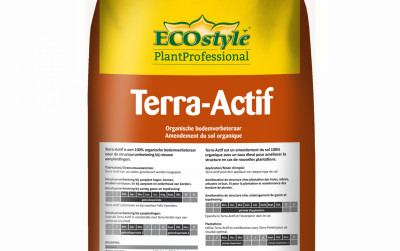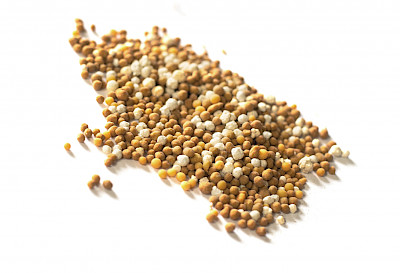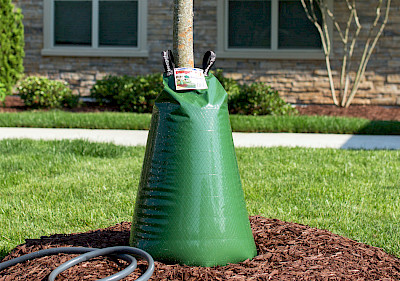How do I plant my tree?
You have selected the right tree that is suitable for the allotted location. Now it is important to prepare this location well, and to plant the tree in the correct way in order to provide optimum growth conditions. Below we explain step by step how to prepare the planting hole, how to plant and anchor the tree, how to approach watering and how to take care of the ground around the tree.
At the bottom of this page you will also find information about soil improvers, fertilizers and watering bags. When you purchase your tree, you will also receive a technical specification sheet with all the necessary information for planting.


Planting hole
The soil in the planting hole should be well aerated to ensure good root development. However, it is important that the roots are stimulated to grow into the underlying soil. Make sure there are no disruptive layers or abrupt transitions from the planting soil to the underlying soil; if present, these should be well loosened before planting. Avoid creating a new impenetrable layer while digging over the soil.The diameter of the planting hole should be two to three times larger than the root ball. For bare root trees, the hole should be at least large enough for the roots to be fully spread out in the hole. The planting hole must not be deeper than the root ball. Break up the walls of the hole and make sure all the soil is well loosened; this is particularly important with heavy soil to prevent the roots from twisting.


Planting the tree
When placing the tree in the planting hole, the root collar must be above ground level. This can easily be identified by the colour difference which indicates how deep the tree was planted in the nursery. The top of the root ball will then be positioned at or just above ground level. With this, the roots will end up just under the soil; this is fine, since the tree will sink slightly after planting. A tree that is planted too deep can die due to lack of oxygen or root rot.The burlap sack and wire basket should not be removed; these provide essential protection for the roots and will disintegrate over time.
Fill the planting hole with a mixture of the existing soil and soil improver. If other soil is used besides the existing, surrounding soil, some of the surrounding soil should be mixed with the new soil and the soil improver. The soil in the planting hole should then be well pressed down. Finally, a one-off application of fertilizer can be given by mixing the fertilizer with the top layer of the soil. Our staff can advise you on the necessary soil improver, fertilizers and the correct dose for your tree or shrub.


Tree anchoring
Place the anchoring stake next to the tree. The necessary anchoring for your tree is dependent on the size and location of the tree.Bare root trees can be anchored with a single tree stake. This should be placed in the ground at a sufficient depth and secured with a rubber band in a figure of eight formation. This prevents damage to the trunk through friction. To ensure that the tree stakes are firmly anchored in the ground, it is often necessary to use a ground drill.
Trees with root ball and with a girth of up to 40 cm should preferably be anchored with three tree stakes. These are joined together with horizontal wooden battens to create a strong structure. The tree is secured in place with nylon tree straps.
For even larger trees, cable anchoring can also be used. Our staff can advise you on the best form of anchoring for your new tree.
When you purchase your tree, you will receive a technical specification sheet with details on the recommended anchoring.


Watering
Watering in the spring and summer after planting is extremely important, especially in the first year. The tree will have lost some of its roots during replanting, which means there are fewer roots available for water absorption. What’s more, the tree has to find its water supply from the limited surface area of the root ball. However, too much water can cause damage to and death of the roots.The amount of water required is dependent on multiple factors and cannot be generalized. Weekly monitoring is therefore essential. The root ball must be kept moist but not wet. When watering, care must be taken to ensure the water does not flow off the surface of the root ball. An irrigation barrier can be used for this; this is an earthen wall that is placed around the root ball. For highly efficient watering the Treegator® watering bag can be used. This ensures a slow, steady release of water for the tree, giving the soil and the roots time to properly absorb the water. This prevents soil compaction which can result from excessive watering in a short time period.
At the bottom of this page you will find more information about the Treegator® watering bags.


Ground around the tree
The majority of the roots are found in the top 20-30 cm of the soil. This is certainly the case for the root hairs, which extend far from the tree and whose job it is to absorb water and minerals from the soil. For this reason, it is extremely important to make sure there is plenty of space around the base of the tree. Therefore, never sow grass right up to the trunk. This would result in far too much competition for water and nutrients. Also make sure the ground around the tree is free from weeds.The soil must not become compacted through heavy rain or too much walking, for example. This can impede root growth. Ensure a good litter layer where the leaves of the tree can decompose where they fall. This guarantees a good humus layer and plenty of organic material in the soil. To achieve this during planting, you may choose to use tree bark for example.
Ecostyle Terra Actif
Ecostyle Terra Actif is a high-quality soil improver with micro-organisms which comprises compost from deciduous tree bark, composted coniferous wood bark and coir (coconut fibre). Terra Actif contains a high level of organic matter: >20%. The added coir results in an airy and loose product, which ensures that extra oxygen and moisture is retained in the soil.
When planting any tree, we always recommend mixing this soil improver with the soil. Please ask our staff for advice about the right amount for your tree or shrub.

Pro LongGrow db
Pro LongGrow db is a controlled-release fertilizer which combines safety, consistent quality and release in a fixed pattern. Each plant requires its own specific nutrition but all plants need steady availability of the nutrients, especially during the first growth season. The release of Pro LongGrow is precisely aligned with the growth of the plant. This makes the product not only efficient, but also safe, since minimal fertilizer residue is left behind.
To give your new tree the best start we recommend using these fertilizers during planting. When you purchase your tree, our staff will advise you on the best amount to use.

Treegator® watering bags
Treegator® watering bags are available in two versions: Treegator® Original and Treegator® Pro Jr.
Treegator® Original is ideal for use with standard trees, and Treegator® Pro Jr. for use with multi-stemmed trees and solitary trees/ shrubs.
The Treegator® watering bags ensure a slow, gradual release of water for 5 to 9 hours. This increases efficiency since the soil and the roots are given the time to properly absorb the water. Moreover, using the Treegator® watering bag eliminates the risk of soil compaction, which can occur through excessive watering in a short time period.

Boomkwekerij De Bruyn bv
- Vennestraat 6a
- 3130 Begijnendijk, België
- E-mail: info@boomkwekerij-debruyn.com
- Tel: +32 16 56 14 27
Opening times October to May
Monday to Friday: 08:00h - 12:00h, 13:00h - 17:30h
Saturday: by appointment
Closed on national and Christmas holidays
Over ons
Onze Bomen
Boom advies
Subscribe to our newsletter
Would you like to keep up to date with our latest news? Subscribe now to our newsletter.
Subscribe